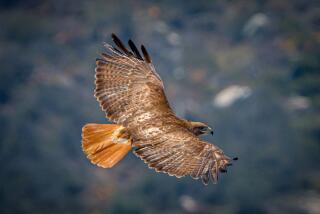Getting Down to Brass Tracks : Survivalist says examining where animals have been helps you connect with the creatures.
Jim Lowery can start a fire with a few pieces of wood and a bow. He can create knives, ax heads and hammers from stone. He can make a fishing net from roots, cedar bark and rawhide.
Lowery also is able to study an animal’s tracks and determine its species, sex, whether it is adult or juvenile, if it had been running or walking and even in which direction it was looking as it passed through the area being studied.
He could be called a survivalist, although that term usually calls to mind the image of a “mountain man” sort who moves his family to Idaho, digs a moat around his hand-built log cabin and waits for an invasion of some unknown outsiders.
Lowery, rather, is a 46-year-old former business journalist who is a teacher of animal tracking and wilderness survival. He doubts that most of his students will ever have to sleep in a pit they have dug or purify water by pouring it through a sieve of grass, although he teaches such skills.
Lowery, who conducts workshops in Orange County, believes his students are interested in what he can teach them for other reasons.
“I think most of our students want to come closer to nature,” he says. “I might have 10 or 12 people in a class, primarily learning to observe nature around them. I ask them what they’re interested in and get 1,500 different answers.
“Tracking isn’t just knowing what went by and when. It’s providing a connection with the animals. We’re accustomed to getting answers from people and books, but when you’re out there alone and the field guide you’re reading doesn’t help, then it’s between you and the animal.
“How badly do you want to know what the data mean? You sit down and examine the tracks. Then, after you get up and walk away, you feel like you’ve had a meeting with the animal. You’ve spent time with it. This is one of your creatures. This is one of your friends. It’s a secret relationship.”
Lowery, who has a master’s degree in German literature and once worked for Business Week, started a school, Earth Skills, four years ago from his San Pedro home.
He and his wife, Mary Brooks, a municipal planner, work together on year-round programs of tracking, nature awareness and wilderness skills.
They have conducted classes for the UC Irvine Biology Department, held weekend sessions at the Desert Studies Center--which is administered by Cal State Fullerton--near Baker, and spoken at the Gene Autry Western Heritage Museum in Los Angeles.
Lowery describes his workshops as “twice as much field work as lecture” and calls the hours actually spent on hands and knees, studying animal tracks, “dirt time.” In fact, his quarterly newsletter carries the name “Dirt Times.”
Even after seven years of study, Lowery does not consider himself an expert in tracking.
“I know a fair amount,” he said. “It can really take years to learn everything you might want to know. I’m still learning.”
Lowery’s mentor is author Tom Brown Jr., an East Coast tracker who is generally regarded as the primary expert in the field. Brown, in turn, was taught by an Apache--not a coincidence, according to Lowery, as most of the techniques to be learned are “truly ancient” and are far better understood by American Indians.
“We are always integrating newly acquired knowledge about Native Californian and other skills into our classes,” says Lowery. “Our classes are based on native people’s techniques. They carry a philosophy of respect and reverence for the earth.”
Lowery’s students--more than 1,200 to date--include naturalists, backpackers, museum docents, science teachers, scout leaders, biology students and photographers. Most range from their mid-20s to mid-40s, “but we’ve had people as young as in their teens to those in their 70s. A 74-year-old woman just completed a rather rigorous weekend program with us.”
Students seem to be equally divided between the sexes, Lowery estimates.
Lowery grew up in Indiana, where he acquired his interest in nature. As he learned more about tracking, he says he also came to know that “we have lost our connection with nature. Even when we go out for hikes and walks, we walk as outsiders. Some people can identify what they’re seeing--types of trees, birds, whatever--but they still aren’t involved. Tracking brings you in.”
After some “dirt time,” Lowery says, a student not only can tell if he or she is examining the tracks of a weasel, fox, rabbit, or bear, but also “when it came by, what it was doing, whether it was male or female, how fast it was moving, whether its head was up or down, whether it had eaten recently, which way it was looking, perhaps even if it was curious about something.”
He works often with children, who seem eager to reach conclusions about their newfound knowledge. “I’ve had youngsters who had just learned to identify rabbit tracks and coyote tracks tell me that the rabbit must have been running from the coyote,” he says.
“Then I might point out that the rabbit appears not to have been running, nor was the coyote, and so they see the animals could not have been in the same place at the same time.”
But tracking can yield more than the ability to recognize a rabbit’s print. A combination of interest and study, Lowery says, can give a student “a picture of the specific animal, not just the footprint of a generic animal. You can almost feel the motion of the animal in your own body.”
The resultant acquired skill is something Lowery calls the “search image.” For example, he says, “if you look for rabbit tracks and have seen enough of them to form images, you begin seeing them all over the place. My nephew, a car freak, spots Ferraris everywhere. As we drive on the freeway at 60 m.p.h., he can see a Ferrari in a driveway three blocks away, and, from a glimpse of a millisecond, tell me what year . . . it is, the horsepower and the price.” Such skills--whether in spotting Ferraris or foxes--are instinctive, Lowery claims. “I’m still just scratching the surface myself,” he said. “There is a tremendous amount of variation. Lopes, gallops, trots, different walks. You learn to see things you never saw before. But it takes a long time to bring your mind to a place where you can see a lot.”
The skills learned in tracking, Lowery believes, could be applied to other areas, among them scientific purposes. “Think of it in connection with surveying,” he said. “A biologist doing random tracking to establish where certain species are and where they go may well establish corridors of wildlife movement.
“That is, once you established the corridors used by the animals, you could keep them open to preserve the genetic diversity. With all the development--Orange County, Santa Monica Mountains, elsewhere--a lot of these corridors are disappearing. We need to provide a place for animals to continue to survive.”
In drought-stricken Southern California, rain is seldom a factor in tracking, but Lowery prefers to track in dry weather.
“A track can be washed away rather rapidly in the rain,” he said, “and of course the terrain is important, as well. In the desert sand, a track can be covered over or blown away in 15 minutes. Sometimes, they can be weeks old. But, even in old tracks, you should still be able to tell if an animal was walking or running.
“The majority of the detail disappears in 12 to 24 hours.”
Lowery likes to compare the skills of tracking with learning the subtleties of an artist or composer.
“If you’ve been listening to Beethoven for a long time,” he said, “and you hear something that sounds like Beethoven, you can draw the conclusion that what you are hearing is Beethoven, even if you don’t recognize it.
“If you have seen 100 gray fox tracks and you suddenly see a track you don’t immediately recognize--but it looks like a gray fox--it probably is.”
This fall, Lowery has scheduled classes in basic tracking (both one-day and from Friday night to Sunday afternoon), advanced weekend tracking, wilderness skills, plant uses, introductory earth philosophy and a weekend earth philosophy workshop.
A one-day basic tracking class will be held at Malibu Creek State Park Oct. 19. The cost is $45. A class in plant uses, including the making of baskets, bows, arrows and rope as well as identifying edible plants, will take place the following day. The cost is $45.
A weekend advanced tracking workshop is scheduled for Oct. 26 and 27 at Joshua Tree National Monument. The cost is $85, including some meals. The final weekend basic tracking workshop of the year will be held at the Desert Studies Center, between Baker and Barstow. The cost is $114, including room and board.
Lowery also works regularly with UC Riverside, the Anza Borrego Natural History Assn., Santa Cruz Mountains National History Assn. and several other groups statewide. He can be reached through Earth Skills, 570 Shepard St., San Pedro 90731, or at (213) 833-4249.






